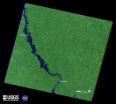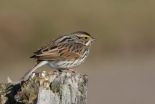(Press-News.org) Flooding along the Missouri River continues as shown in recent Landsat satellite images of the Nebraska and Iowa border. Heavy rains and snowmelt have caused the river to remain above flood stage for an extended period.
A Landsat 5 image of the area from May 5, 2011 shows normal flow. In contrast, a Landsat 7 image from July 17 depicts flood conditions in the same location.
A national overview map of streamflow provided by U.S. Geological Survey (USGS) WaterWatch graphically portrays the immense geographic extent of flooding in the Missouri River basin.
Monitoring both floods and droughts, the USGS WaterWatch internet site displays maps, graphs, and tables that describe current and past streamflow conditions for the United States. The real-time streamflow data is generally updated on an hourly basis.
The Landsat Program is a series of Earth-observing satellite missions jointly managed by NASA and the U.S. Geological Survey. Landsat satellites have been consistently gathering data about our planet since 1972. They continue to improve and expand this unparalleled record of Earth's changing landscapes, for the benefit of all. The next Landsat satellite is scheduled to launch in December 2012.
INFORMATION:
For the USGS WaterWatch website, please visit:
http://waterwatch.usgs.gov/new/index.php?id=ww
For more information about the Landsat launching in 2012: http://ldcm.gsfc.nasa.gov
Landsat satellites track continued Missouri River flooding
2011-07-22
ELSE PRESS RELEASES FROM THIS DATE:
A new breed: Highly productive chickens help raise Ugandans from poverty
2011-07-22
In the fight to improve global health, alleviate hunger, raise living standards and empower women in the developing world, chickens have an important role to play.
Jagdev Sharma, a researcher at the Center for Infectious Diseases and Vaccinology at Arizona State University's Biodesign Institute has been investigating the advantages of a more productive species of chicken for villagers in rural Uganda. He reports his findings this week at the American Veterinary Medical Association Meeting in Saint Louis, Missouri.
The star of this developing story is a type of chicken ...
Fermilab experiment discovers a heavy relative of the neutron
2011-07-22
Scientists of the CDF collaboration at the Department of Energy's Fermi National Accelerator Laboratory announced the observation of a new particle, the neutral Xi-sub-b. This particle contains three quarks: a strange quark, an up quark and a bottom quark (s-u-b). While its existence was predicted by the Standard Model, the observation of the neutral Xi-sub-b is significant because it strengthens our understanding of how quarks form matter. Fermilab physicist Pat Lukens, a member of the CDF collaboration, presented the discovery at Fermilab on Wednesday, July 20.
The ...
GOES satellite sees a triple header in the tropics
2011-07-22
The GOES-13 satellite captured a triple-header in the tropics today when it captured three tropical cyclones in one image in the Northern Hemisphere.
A visible image taken from the GOES-13 satellite on July 20 at 14:45 UTC (10:45 a.m. EDT) and shows a consolidating low pressure area called System 99L in the eastern North Atlantic Ocean, Tropical Storm Bret several hundred miles east of South Carolina, and a large Hurricane Dora off the west coast of Mexico. The image was created by the NASA/NOAA GOES Project at NASA's Goddard Space Flight Center in Greenbelt, Md.
System ...
It's no sweat for salt marsh sparrows to beat the heat if they have a larger bill
2011-07-22
Birds use their bills largely to forage and eat, and these behaviors strongly influence the shape and size of a bird's bill. But the bill can play an important role in regulating the bird's body temperature by acting as a radiator for excess heat. A team of scientists have found that because of this, high summer temperatures have been a strong influence in determining bill size in some birds, particularly species of sparrows that favor salt marshes. The team's findings are published in the scientific journal Ecography, July 20.
Scientists at the Smithsonian Migratory ...
Unlisted ingredients in teas and herbal brews revealed in DNA tests by high school students
2011-07-22
Take a second look at your iced or steaming tea. Guided by scientific experts, three New York City high school students using tabletop DNA technologies found several herbal brews and a few brands of tea contain ingredients unlisted on the manufacturers' package.
The teen sleuths also demonstrated new-to-science genetic variation between broad-leaf teas from exported from India versus small-leaf teas exported from China.
Guided by DNA "barcoding" experts at The Rockefeller University, an ethno-botanist at Tufts University and a molecular botany expert at The New York ...
UCSF study highlights success of brain surgery for severe epilepsy
2011-07-22
Two-thirds of people with severe and otherwise untreatable epilepsy were completely cured of their frequent seizures after undergoing neurosurgery at the University of California, San Francisco Medical Center, according to a new study that examined 143 of these patients two years after their operations.
The new study not only shows the promise of this type of neurosurgery at treating severe epilepsy, it also highlights how research into brain imaging may help to further improve results for people who have such operations.
"Surgery can be a powerful way to stop this ...
Whole sequence variation map reveals insight into evolutionary studies of rhesus macaque
2011-07-22
July 20, 2011 – BGI (previously known as the Beijing Genomics Institute), the largest genomics organization in the world, and Kunming Institute of Zoology, Chinese Academy of Sciences, together published the whole sequence variation map of rhesus macaque (Macaca mulatta) in Genome Biology on July 6th, 2011 (http://genomebiology.com/2011/12/7/R63). The study provides available resources for evolutionary and biomedical research.
Rhesus macaque, also called the Rhesus monkey, is one of the best known species of old world monkeys. Human and Rhesus macaque share a most recent ...
Cedars-Sinai movement disorders expert on international task force for dystonia treatment
2011-07-22
LOS ANGELES (July 20, 2011) –Neurologist Michele Tagliati, MD, director of the Movement Disorders Program at Cedars-Sinai Medical Center, served on an elite international task force commissioned by the Movement Disorder Society to provide insights and guidance on deep brain stimulation for dystonia, an uncommon condition that causes sustained, sometimes crippling muscle contractions.
The resulting articles, describing the data reviewed and outlining the group's conclusions, recommendations and points to be addressed in future research, published online last month in ...
Computer simulations aid understanding of bacterial resistance against commonly used antibiotics
2011-07-22
A recent study into the interactions between aminoglycoside antibiotics and their target site in bacteria used computer simulations to elucidate this mechanism and thereby suggest drug modifications.
In the article, which will be published on July 21st in the open-access journal PLoS Computational Biology, researchers from University of Warsaw, Poland, and University of California San Diego, USA, describe their study of the physical basis of one bacterial resistance mechanism - mutations of the antibiotic target site, namely RNA of the bacterial ribosome. They performed ...
Chromosome number changes in yeast
2011-07-22
Researchers from Trinity College Dublin have uncovered the evolutionary mechanisms that have caused increases or decreases in the numbers of chromosomes in a group of yeast species during the last 100-150 million years. The study, to be published on July 21st in the open-access journal PLoS Genetics, offers an unprecedented view of chromosome complement (chromosome number) changes in a large group of related species.
A few specific cases of chromosome number changes have been studied in plants and animals, for example the fusion of two great ape chromosomes that gave ...





